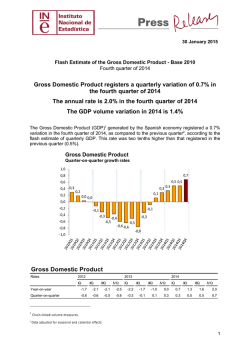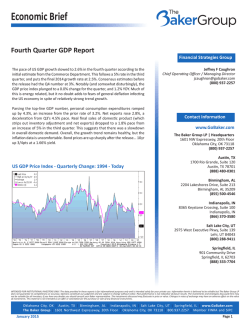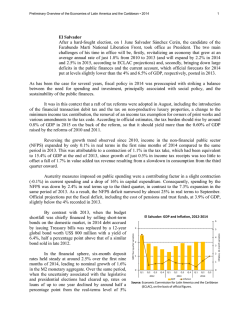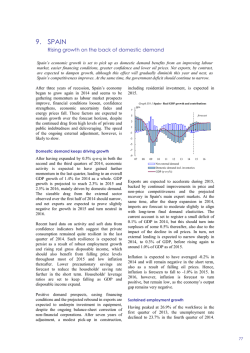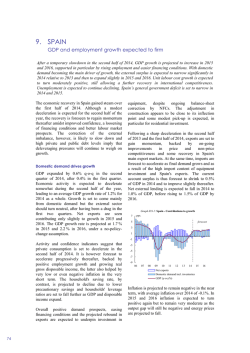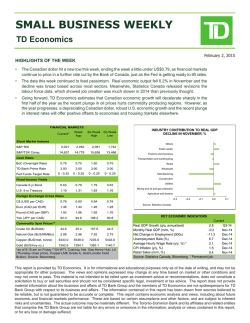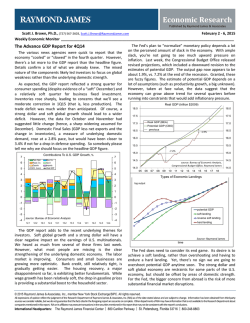
Quarterly regional GDP flash estimates for the Spanish
Working Paper DT/2015/3 Quarterly regional GDP flash estimates for the Spanish economy (METCAP model) Abstract In this paper we propose a methodology to estimate on a quarterly basis the GDP of the different regions of Spain, providing quarterly profiles for the annual official observed data. In this way, the paper offers a new instrument for short-term monitoring that allows the analysts to quantify the degree of synchronicity among regional business cycles. Technically, we combine time series models with benchmarking methods to process shortterm monthly and quarterly indicators and to estimate quarterly regional GDPs ensuring their temporal and transversal consistency with the National Accounts data. The methodology addresses the issue of non-additivity taking into account explicitly the transversal constraints imposed by the chain-linked volume indexes used by the National Accounts and provides an efficient combination of structural as well as short-term information. The methodology is illustrated by an application to the Spanish economy, providing realtime quarterly GDP estimates for the period 2000:1 – 2014:4. Writen by Ángel Cuevasτ and Enrique M. Quilisτ Revised by Rafa Frutos and Gabriel Perez-Quirós Approved by José Marín Key words: balancing, benchmarking, dynamic factor models, national accounts, regional analysis. JEL: C53, C43, C82, R11 τ Spanish Independent Authority for Fiscal Responsibility We thank A. Abad, J.L. Escrivá, A. Espasa, R. Frutos and G. Pérez-Quirós for their input at different stages of the project. Any views expressed herein are those of the authors and not necessarily those of the Spanish Independent Authority for Fiscal Responsibility La Autoridad Independiente de Responsabilidad Fiscal (AIReF) nace con la misión de velar por el estricto cumplimiento de los principios de estabilidad presupuestaria y sostenibilidad financiera recogidos en el artículo 135 de la Constitución Española. Contacto AIReF: C/José Abascal, 2, 2º planta. 28003 Madrid.Tel. +34 917 017 990 Email: [email protected]. Web: www.airef.es Este documento no refleja necesariamente la posición de la AIReF sobre las materias que contiene. La documentación puede ser utilizada y reproducida en parte o en su integridad citando su procedencia. DT/2015/3 Summary 1 Introduction ............................................................................................... 3 2 Data ............................................................................................................ 4 2.1 2.2 2.3 3 Regional accounts ................................................................................ 6 Short-term regional indicators ............................................................... 7 Autonomous regional accounts ............................................................. 9 Econometric approach ............................................................................10 3.1 3.2 3.3 3.4 Processing short-term indicators ..........................................................10 Design of regional GDP trackers using dynamic factor analysis ..........11 Quarterly regional GDPs: initial (unbalanced) estimation .....................16 Quarterly regional GDPs: final (balanced) estimation ..........................18 4 Numerical results: Spanish quarterly regional GDPs. ..........................21 5 Conclusions .............................................................................................23 6 References................................................................................................25 A. Appendix: short-term regional indicators..............................................28 May 2015 Quarterly regional GDP flash estimates for the Spanish economy (MEPTCA model) 2 DT/2015/3 1 Introduction Monitoring economic conditions at the regional level is an important component in the assessment of the economic state of large and medium size countries as well as for countries with decentralized administrative systems that allow the application of specific economic policies. This is clearly the case for Spain: its medium economic size and its decentralized fiscal system are good reasons to consider explicitly the regional dimension in the evaluation of its global economic conditions and to do it in a timely manner. In addition, fiscal monitoring and forecasting assessment at the regional level is a key mandate for the Independent Authority for Fiscal Responsibility (Autoridad Independiente de Responsabilidad Fiscal, AIReF) and this is why we propose in this paper the use of a modular and transparent system to ascertain the economic conditions of the Spanish economy at the regional level. In this way, for instance, AIReF can evaluate the degree of homogeneity of the short-term economic conditions at the regional level or estimate its own measures of cyclical and structural fiscal conditions for each region. The design of the system incorporates the available statistical sources of information at the structural level as well as at the short-term level, satisfying their consistency by means of benchmarking techniques (temporal disaggregation and balancing). At the same time, the system is symmetric in the use of the regional information ensuring, that all the regions are considered in the same way. In this paper we propose a methodology to obtain quarterly estimates of the Gross Domestic Product (GDP) for all the Spanish regions, derived in a consistent way with the official available data provided by the National Accounts, both Regional Accounts (RA) and Quarterly National Accounts (QNA). In this way, early (or flash) estimates of quarterly GDP at the regional level can be released at the same time as the national GDP. Finally, the methodology ensures that transversal consistency is compliant with the chain-linking procedures, circumventing its non-additive features in the balancing step. May 2015 Quarterly regional GDP flash estimates for the Spanish economy (MEPTCA model) 3 DT/2015/3 The methodology has three main stages: 1. Processing of the high frequency indicators available at the regional level and estimation, for each region, of a GDP tracker that combines the available short term information using dynamic factor analysis. 2. Temporal disaggregation and interpolation of annual regional GDPs using the corresponding GDP trackers estimated in step 1. 3. Balancing of these initial quarterly estimates in order to ensure transversal consistency with the national quarterly GDP, preserving at the same time the temporal consistency achieved in the previous stage. Our paper relies heavily on Cuevas et al. (2011, 2015), modifying their work in two critical issues. First, we introduce dynamic factor models to estimate the high-frequency (quarterly) regional GDP trackers instead of static factor models. In this way, we enrich the dynamic specification of the models and we obtain a measure of the uncertainty around the GDP tracker. Second, we expand their set of indicators to take into account the financial conditions at the regional level. The paper is organized as follows. The second section describes the available statistical sources of information used by the system. The third section is devoted to the modeling approach, going into detail of its main steps. A complete and in depth application of the methodology using Spanish data appears in section four. The paper ends presenting the main conclusions and future lines of research. 2 Data The model requires as input three elements that vary according to their sampling frequency (annual or quarterly), their spatial coverage (regional or national) and their method of compilation (National Accounts or short-term indicators). May 2015 Quarterly regional GDP flash estimates for the Spanish economy (MEPTCA model) 4 DT/2015/3 The variables of the system are: regional GDPs (y), national GDP (z) and regional shortterm indicators in original or raw1 form (xr). Upper-case letters refer to annual variables while lower-case letters refer to quarterly variables. Let T=1..N be the annual (lowfrequency) index, s=1..4 the seasonal index within a natural year and j=1..M the regional (cross-section) index. In addition, for each s, T and j we observe k indicators, indexed by i. Hence, Y={YT,j: T=1..N; j=1..M} is a NxM matrix comprising the annual regional GDPs that play the role of temporal benchmarks of the system. Aggregation of the regional GDPs generates the GDP at the national level2. Variable z is a nx1 vector comprising the observed quarterly GDP provided by the QNA, being n≥4N the number of available quarterly observations. This figure is available more timely than the regional data and shares with them the corresponding annual GDP volume index3: [1] ZT 1 4 zs, T 4 s 1 Finally, xr is an nxkxM matrix comprising the observed raw quarterly indicators that operate as high-frequency proxies for the regional aggregates Y. As will be explained later, we work with the seasonally and calendar adjusted indicators (x) instead of the raw indicators (xr) and we combine them to derive a quarterly GDP tracker for each region. Only the indicators x are observed at the three dimensions of the system: T (annual index), s (seasonal index) and j (regional index). Therefore, they provide the interpolation basis (formally, once the GDP tracker has been constructed) for Y (across the quarterly 1 That is, incorporating seasonal and calendar effects. 2 Again, aggregation is performed according to the chain-linking methodology. For example, taking 2014 as a reference, the QNA released its first estimate of 2014:Q4 on February, 26th, 2015 while the RA released its first estimate of 2014 on March, 27th, 2015. Both estimates share the annual figure for 2014 implicitly provided by the QNA by means of temporal aggregation of the four quarters of 2014. 3 May 2015 Quarterly regional GDP flash estimates for the Spanish economy (MEPTCA model) 5 DT/2015/3 dimension s) and z (across the regional dimension j). In other words, our objective is to estimate y using x as interpolators and consistently with both Y and z. Table 1 resumes the relationship among the inputs of the system (Y, z and x) and the output (y) for a simplified case with two regions (M=2) and two years (T=2). The first year is complete while the second year is incomplete (i.e., the last two quarters are not available for x and z and the annual figure for Y is not available either). Table 1: Information set Year Quarter x1 Region 1 y1 1 x1,1,1 y1,1,1 2 3 4 1 2 3 4 x1,2,1 x1,3,1 x1,4,1 x1,1,2 x1,2,2 y1,2,1 y1,3,1 y1,4,1 y1,1,2 y1,2,2 1 2 Y1 Y1,1 x2 Region 2 y2 x2,1,1 y2,1,1 x2,2,1 x2,3,1 x2.4,1 x2,1,2 x2,2,2 y2,2,1 y2,3,1 y2,4,1 y2,1,2 y2,2,2 Y2 Nation z z1,1 Y2,1 z2,1 z3,1 z4,1 z1,2 z2,2 Note: bold variables are temporal constraints (Y) or transversal constraints (z). In this simplified example we want to estimate during the first year the quarterly regional GDPs (yj,s,1) consistently with their annual counterparts (Yj,1) and satisfying the transversal constraint that links each quarter of the regional GDPs with the national quarterly GDP (zs,1). The annual constraints do not apply during the second year since Yj,2 are not available. So, the only binding constraint is the transversal constraint. 2.1 Regional accounts Regional Accounts (RA) have an annual frequency and define the temporal benchmark that our quarterly GDP estimates have to match. They define a homogeneous and consistent measure across the regional dimension, including nominal and real valuation of economic aggregates, coherence with the national data and fulfillment of the principles contained in the European System of National Accounts. May 2015 Quarterly regional GDP flash estimates for the Spanish economy (MEPTCA model) 6 DT/2015/3 Apart from its annual frequency, another feature of the RA is its delay with respect to the QNA. Our methodology solves this drawback, providing quarterly regional GDPs consistent with the national quarterly GDP, taking into account the chain-linking procedures that underlie its compilation. Note that the same principles of volume estimation using chain-linked indices have been used in our analysis and that we have applied the same procedures of seasonal and calendar adjustment used by the QNA. Structural consistency is also ensured since the quarterly regional GDPs are consistent with their annual Regional Accounts counterparts. The fact that both QNA and RA share the same National Accounts (NA) framework4 provides the base for the consistency obtained in our analysis. In this way, we can use the quarterly regional estimates to derive structural measures at the regional level. An additional drawback of the RA is their lack of synchronicity with the Annual Accounts during four months. Annual and QNA are revised each August but RA incorporate those revisions in December. The following figure illustrates the case: Figure 1: Internal synchronicity of the National Accounts Year Month ANA, QNA RA 1 2 3 4 5 T-1 6 7 T 8 9 10 11 12 1 2 3 4 5 6 7 8 9 10 11 12 Release T-2: Release T-1: Release T: 2.2 Short-term regional indicators This subsection details the indicators that have been selected for model estimation. The selection process was carried out under the premise that the indicators should be available timely and should provide a meaningful economic measure for the regional 4 In particular, the 2010 European System on National Accounts (ESA-2010). May 2015 Quarterly regional GDP flash estimates for the Spanish economy (MEPTCA model) 7 DT/2015/3 economies. An additional requirement is that they should be homogeneously compiled for all the regions. The criteria for the choice of these variables is to consider the regional counterpart of all the indicators used in the compilation of the Quarterly National Accounts, see Álvarez (1989), Martínez and Melis (1989), INE (1993) and Álvarez (2005). To fulfill this goal, we have prepared a set of monthly regional indicators that provides a fairly comprehensive basis for analyzing and monitoring GDP at the regional level. This set offers a highfrequency approximation to the behavior of the main macroeconomic aggregates, both real and financial. The final selection of the indicators has been performed using a stepwise procedure5. The starting point is a minimal set of indicators for each region that represent the main economic sectors: index of industrial production (IPI), services sector activity index (IAS), new building permits: total area to build in housing (VIS) for the industrial, construction and services sector, respectively. In addition, we have included a measure of aggregate employment (registered workers at the social security system, AFI) and an indicator of the financial conditions (total Credit to resident sectors, CRE). The remaining indicators listed in the Appendix A have been ranked according to their correlations with the corresponding regional GDP growth. In order to consider symmetrically all the regions, the average correlation defines the ranking. The stepwise procedure adds the more correlated indicator to the dynamic factor model to estimate new regional GDP trackers. If the correlation of the new regional GDP tracker increases, the indicator is added to the model. Otherwise, the indicator is dropped from the list. The procedure is repeated until the full list is exhausted. 5 See the Appendix A for a detailed description of all the indicators that have May 2015 Quarterly regional GDP flash estimates for the Spanish economy (MEPTCA model) 8 DT/2015/3 The selected indicators are: AFI: Social security system: registered workers. IPI: Index of Industrial Production. PER: Overnight stays in hotel establishments. IAS: Services sector activity indicator. ICM: Retail sales index. IMP: Imports of goods. VIS: New building permits: total area to build in housing. HIP: Mortgages on housing. CRE: Total Credit: public administration and other resident sectors. DEP: Deposits: public administration and other resident sectors. GAS: consumption of petroleum products. The short-term indicators, in order to be consistent with the QNA data, have been seasonally and calendar adjusted. Quarterly indicators have been temporally disaggregated to the monthly frequency by means of the quadratic optimization procedure of Boot et al. (1965). 2.3 Autonomous regional accounts Several Spanish regions compile their own GDP at the quarterly frequency. Although all of them share the general principles contained in the European System of National Accounts they are not homogeneous in their methodology, selection of sources, operational procedures and time coverage. This lack of homogeneity precludes their use as an additional source of information in the model. May 2015 Quarterly regional GDP flash estimates for the Spanish economy (MEPTCA model) 9 DT/2015/3 3 Econometric approach In this section we present the main steps of the proposed methodology. The modeling approach consists of three basic steps: (i) seasonal adjustment of regional short-term raw indicators and construction of GDP tracker for each region by means of factor analysis, (ii) initial quarterly estimates of regional GDP provided by benchmarking and (iii) enforcement of the transversal constraint that links the regional quarterly GDPs with their national counterpart. This aggregation constraint must be consistent with the chain-linking procedure used to compile quarterly GDP at the national level, dealing with the non-additivity issue in an appropriate way. We now turn to examine the three stages in more detail but, to simplify the exposition, we first present the required information set. 3.1 Processing short-term indicators Typically, short-term regional economic indicators are compiled in raw form by the statistical agencies. However, the volume GDP used for short-term monitoring at the national level is calculated in two ways: using raw indicators or using seasonal and calendar adjusted indicators. Since seasonal and calendar effects could be quite different between indicators and the macroeconomic aggregates, the second procedure for the calculation of the GDP seems more reliable. Usually these GDP figures are referred as seasonal and calendar adjusted. In order to ensure the homogeneity between both sources of information, regional raw indicators and seasonally adjusted quarterly national GDP, we apply an ARIMA modelbased correction that filters out the raw data from seasonal and calendar effects, if they are present. The procedure has been implemented using the TRAMO-SEATS program, see Gómez and Maravall (1995) and Caporello and Maravall (2004). Formally: [2] May 2015 xi, j,s,T V(B, F; i, j) xri, j,s,T Quarterly regional GDP flash estimates for the Spanish economy (MEPTCA model) 10 DT/2015/3 where xri,j,s,T is the raw short-term indicator6; V() is the Wiener-Kolmogorov filter symmetrically defined on the backward and forward operators B and F and θi,j are the parameters of the filter derived consistently with those of the ARIMA model for xri,j,s,T, see Gómez and Maravall (1998a, 1998b) for a detailed exposition of the model-based approach used by TRAMO-SEATS. If the indicators are available at the monthly frequency, seasonal adjustment is performed on the monthly series. The resulting series are temporally aggregated to the quarterly frequency. We have used TRAMO-SEATS because it is the method used by the Spanish National Statistical Institute (NSI) to adjust GDP from seasonal effects. In practice, several short-term economic indicators are used to monitor and estimate regional GDPs. These indicators are individually processed according to [2] and then linearly combined, producing a composite indicator that will be used as the highfrequency proxy for regional GDPs. As we shall explain in the third section, we use dynamic factor analysis to estimate a GDP tracker indicator for each region because it provides an objective and simple way to combine the available indicators. 3.2 Design of regional GDP trackers using dynamic factor analysis GDP tracker for each region are estimated by means of a dynamic one-factor model that captures in a parsimonious way the dynamic interactions of a set of monthly economic indicators. The common factor of the system is estimated by means of the Kalman filter, after casting the factor model in state space form. On the basis of this factor we design a GDP tracker that is related to annual RA data through benchmarking techniques (temporal disaggregation). The entire procedure has been adapted to operate with unbalanced data panels. Dynamic factor analysis is based on the assumption that a small number of latent variables generate the observed time series trough a stochastically perturbed linear structure. Thus, the pattern of observed co-movements is decomposed into two parts: If calendar effects (e.g., Easter effect and trading day effect) are present, a preliminary correction is also performed. Without loss of generality, we will continue to call the possibly calendar-corrected data as raw data. 6 May 2015 Quarterly regional GDP flash estimates for the Spanish economy (MEPTCA model) 11 DT/2015/3 communality (variation due to a small number of common factors) and idiosyncratic effects (specific elements of each series, uncorrelated along the cross-section dimension). In this paper we assume that the observed, stationary growth signals of k monthly indicators are generated by a factor model: zi,t ift ui,t [3] Being: t=1..n, quarterly time index t=1..sT. zi,t=(1-B)ln(xi,t): i-th indicator growth signal at time t. i: i-th indicator loading on common factor. ft: common factor at time t. ui,t: specific or idiosyncratic component of i-th indicator at time t. The loadings i measure the sensitivity of the growth signal of each indicator for changes in the factor. Equation [3] only considers static (i.e., contemporaneous) interactions among the observed indicators trough its common dependence on a latent factor. The model should be expanded in order to adapt it to a time series framework, thereby adding a dynamic specification for the common factor and the idiosyncratic elements. A second-order autoregression, AR(2), provides a sufficiently general representation for the common factor: [4] (1 1B 2B2 ) ft at at ~ iid N(0,1) In [4] B is the backward operator Bft=ft-1 and the variance of the innovation has been normalized. Depending on the characteristic roots of 2(B) the model may exhibit a wide variety of dynamic behaviors. May 2015 Quarterly regional GDP flash estimates for the Spanish economy (MEPTCA model) 12 DT/2015/3 We consider an AR(1) specification for the dynamics of the specific elements, allowing for some degree of persistence: [5] (1 iB) ui,t bi,t i 1 bi,t ~ iid N(0, vi ) Finally, we assume that all the innovations of the system are orthogonal: [6] E(atbi,t h ) 0 E(bi,tb j,t h ) 0 i, t, h i, j, t, h Model [3]-[6] attempts to represent the static as well as the dynamic features of the data. We estimate the common and idiosyncratic factors using the Kalman filter, after a suitable reparameterization of the model in state-space form. The reparameterization requires the introduction of a state vector that encompasses all the required information needed to project future paths of the observed variables from their past realizations. In our case, this vector is: [7] t [ft ft 1 u1,t uk,t ]' The corresponding measurement equation is: [8] Zt L 0kx1 Ik ' t H t L={i i=1..k} represents the loading matrix. This equation allows us to derive the observed indicators from the (unobservable) state vector. The transition equation completes the system and characterizes its dynamics: [9] t Gt 1 Vt G is a square matrix with dimension k+2: May 2015 Quarterly regional GDP flash estimates for the Spanish economy (MEPTCA model) 13 DT/2015/3 [10] 1 2 1 0 G 0 0 0 0 0 0 1 0 0 0 0 0 0 0 0 k The innovations vector Vt is: [11] Vt [at 0 b1,t bk,t ]' Vt evolves as a Gaussian white noise with diagonal variance-covariance matrix as follows: [12] 1 0 Q EVt Vt ' 0 0 0 0 0 0 0 v1 0 0 0 0 0 0 0 0 0 vk We assume that the time index t goes from 1 to T. The application of the Kalman filter requires = [H, G, Q] to be known. Since the model is not small-scale, full-system maximum likelihood estimates for are difficult to implement. Our solution was to derive them from the static version of the model, using the transversal panel. Once we have estimated the common factor via Kalman filter, we can obtain a level time series Ft|t through the integration process described in Kim and Nelson (1999). Formally: [13] Ft|t Ft|t 1 ft|t The recursion [13] starts from a given initial condition, i.e. F1 | 0 = 100. One of the major operational problems faced while analyzing multiple time series is the incomplete nature of the available information. In general, the availability of different indicators is not homogeneous, which leads to the generation of a non-overlapping sample. May 2015 Quarterly regional GDP flash estimates for the Spanish economy (MEPTCA model) 14 DT/2015/3 Figure 2: Unbalanced panel data 1 2 3 Indicator 4 5 6 7 8 Longitudinal panel ... ... ... ... ... ... ... ... Observation 1 2 3 Cross-section panel Dark grey: observed Light grey: non observed T1 T2 One way to deal with unbalanced panels consists in working only with complete panels, in the time dimension or in the cross-section dimension. As shown in Figure 2.3, in the first case we may discard a large number of the relevant indicators, with likely adverse effects on factor estimation accuracy and forecasting performance. In the second case, the number of observations may be too small when some series have a short span, making the forecasting or backasting horizon too long. Given these drawbacks we propose a way to utilize all available information, both on the cross-section dimension and on the time dimension. The method, which is partially based on Stock and Watson (2002) and Giannone et al. (2006), relies on an iterative process with the following steps: 1. Estimation of a static factor model by principal components using the longitudinal panel data. 2. The indicators that have been excluded from the longitudinal panel are individually regressed (by ordinary least squares, OLS) on the common factor. May 2015 Quarterly regional GDP flash estimates for the Spanish economy (MEPTCA model) 15 DT/2015/3 The estimated parameters are then used to calculate the missing data in these series from t=1 to t=T1. 3. The parameters = [H, G, Q] required by the Kalman filter are estimated using the transversal panel, ensuring a symmetric treatment of the available information. 3.3 Quarterly regional GDPs: initial (unbalanced) estimation Preliminary estimates of quarterly GDP at the regional level are compiled using benchmarking techniques, see Di Fonzo (1987, 2002) and Proietti (2006) for an in-depth exposition. These techniques play an important role in the compilation practices of Quarterly National Accounts around the world, see Eurostat (1998) and Bloem et al. (2001). We have considered several benchmarking procedures to derive the preliminary GDP estimates: Chow-Lin (1971), Fernández (1981), Santos Silva-Cardoso (2001) and Proietti (2006). All of them hinge around a dynamic linear model that links the (observable) high-frequency indicator (GDP tracker in our case, estimated using dynamic factor modeling) with the (unobservable) regional GDP7: yt yt 1 0 Ft 1 Ft 1 ut [14] The innovation u follows an AR(1) process: ut ut 1 at [15] Finally, the random shock that drives the innovation u is Gaussian white noise process: at ~ iidN(0, va) [16] The model includes a temporal constraint that makes y quantitatively consistent with its annual counterpart Y: 7 To keep the notation simple we have omitted the regional index j. May 2015 Quarterly regional GDP flash estimates for the Spanish economy (MEPTCA model) 16 DT/2015/3 Y Cy [17] C is the temporal aggregation-extrapolation matrix defined as: C (IN c | ON,nsN) [18] Where N is the number of low-frequency observations, stands for the Kronecker product, c is a row vector of size s which defines the type of temporal aggregation and s is the number of high frequency data points for each low frequency data point. If c=[1,1,...,1] we would be in the case of the temporal aggregation of a flow, if c= [1/s,1/s,...,1/s] in the case of the average of an index and, if c=[0,0,...,1], an interpolation would be obtained. In our case, s=4. Extrapolation arises when n>sN. In this case, the problem can easily be solved by simply extending the temporal aggregation matrix by considering new columns of zeroes which do not distort the temporal aggregation relationship and that do not pose any difficulty to the inclusion of the last n-sN data points of the indicators in the estimation process of y. The different benchmarking methods depend on the values of the parameters in [14] and [15] according to table 2: Table 2: Benchmarking methods Parameter Method Chow-Lin Fernández 1 0 0 (0,1) 0 0 1 Santos Silva-Cardoso (0,1) 0 0 Proietti (0,1) ≠0 0 The methods of Chow-Lin and Fernández places the dynamics in the innovation, that may follows a stationary AR(1) process (Chow-Lin) or a non-stationary I(1), random walk process (Fernández)8. On the other hand, the methods of Santos Silva-Cardoso and Litterman (1983) proposes a methodology affine to those of Chow-Lin and Fernández. However, the empirical and Monte Carlo evidence show that its performance is sometimes disappointing. This fact is due 8 May 2015 Quarterly regional GDP flash estimates for the Spanish economy (MEPTCA model) 17 DT/2015/3 Proietti places the dynamics in the variables y and x, treating the innovation as a purely random shock9. The estimation of the parameters and the unobserved time series y is performed by maximizing the implied log-likelihood profile of the low-frequency model10. This optimization is performed by means of a grid search on the stationary domain of or , and pinning down the values of and σ that maximizes the log-likelihood function conditioned on the selected value for or , see Bournay and Laroque (1979) for an indepth exposition. The computations have been carried on using the functions written in Matlab by Abad and Quilis (2005). 3.4 Quarterly regional GDPs: final (balanced) estimation The estimates derived in the previous step do not verify the transversal constraint that should relate them to the national quarterly GDP, satisfying the same type of relationship that links annual regional GDPs and annual national GDP. We solve the problem applying a multivariate balancing procedure, in particular a multivariate extension of the Denton (1971) method. This extension can be expressed in matrix form, as in Di Fonzo (1990) and Di Fonzo and Marini (2003), as well as in state space form, see Proietti (2011). In this paper we have adopted the former approach, using the functions written in Matlab by Abad and Quilis (2005). This balancing method depends on the formulation of additive constraints. However, volume indexes compiled according to the chain-linking methodology are non-additive, see Bloem et al. (2001) and Abad et al. (2007). Fortunately, we can transform the chainlinked measures in order to write them in an additive form and then use the powerful machinery of balancing procedures to ensure transversal and temporal consistency. Finally, we can express the results in the initial chain-linked format by reversing the transformation. to the flatness of the implied likelihood profile and, therefore, the corresponding observational equivalence in a wide range of values for its dynamical parameter, see Proietti (2006). Gregoir (1994) and Salazar et al. (1994) also propose methods in which the dynamics of y and x play an explicit role. 9 10 The low-frequency model incorporates the temporal aggregation constraints [17] and [18]. May 2015 Quarterly regional GDP flash estimates for the Spanish economy (MEPTCA model) 18 DT/2015/3 The constraint that links regional and national quarterly volume GDP is: y j,s, T zt, T Wj, T 1 Z j T 1 Y j , T 1 [19] Where zt,T is the national quarterly volume GDP, Wj,T-1 is the weight of region j in year T1 and yj,s,T is the quarterly volume GDP of the j-th region11. Finally, ZT and Yj,T are the annual counterparts zt,T of and yj,s,T. After some algebraic manipulations, we can express the constraint in additive form: z t, T [20] ZT 1 rt , T y Wj,T 1 Yjj,,Ts,T1 wr j,s,T j j wrj, t , T In [20] the relationship between the national ratio rt,T and the weighted regional ratios wrj,s,T is additive. Plugging the initial estimates derived according to [3]-[7] into [9] we obtain the preliminary, unbalanced estimates: [21] wr j*,s, T Wj,T 1 ŷ j,s, T Yj,T 1 The balanced and temporally consistent time series wr**j,t,T are the output from the following constrained quadratic optimization program: Weights are computed using GDPs valued at current prices, see Abad et al. (2007) for a complete derivation. 11 May 2015 Quarterly regional GDP flash estimates for the Spanish economy (MEPTCA model) 19 DT/2015/3 [22] MIN wr (wr wr )'D' D(wr wr ) s.t. H wr R e Being: 1' In H M IM C z Re WR and Where 1M is a column vector of ones and WR is the annual counterpart of the weighted regional ratios written in matrix form. In the program [22] the objective function reflects the volatility of the discrepancies between the quarter-to-quarter growth rates of the balanced series and those of the unbalanced ones. After some mathematical manipulation, an explicit expression can be derived: [23] 1 wr wr (D' D)1H' H(D' D)1H' (R e Hwr ) The interpretation of equation [23] is straightforward: the quarterly balanced series are the result of adding up a correction factor to the unbalanced series. This correction factor originates from the distribution of the discrepancy between the preliminary unbalanced estimates and the constraint series Re. Once we have obtained the consistent weighted ratios, we can reverse the transformation [20] to derive the final estimates of the quarterly regional GDP in volume terms: [24] yj,s, T wr j,s, T Yj,T 1 Wj, T 1 In this way, the estimates of quarterly GDP derived in the previous equation are quantitatively consistent in their time dimension (taking as benchmark their annual regional counterparts) and in their cross-section dimension (generating the GDP provided by the QNA by regional aggregation). We should also emphasize that the consistency extends to the methodological dimension too, since the chain-linking procedures in current use by the National Accounts have been properly taken into May 2015 Quarterly regional GDP flash estimates for the Spanish economy (MEPTCA model) 20 DT/2015/3 account. Finally, using time series methods to project the basic short-term indicators we can derive nowcasts (or flash estimates) of regional quarterly GDP in a timely way. As a summary, the figure 3 presents a picture of the complete procedure. The diagram emphasizes the binding constraints and the homogeneous processing of information at the regional level. Note that the box labeled “balancing” embeds the de-chaining and rechaining steps required to circumvent the non-additive features of the chain-linked volume indexes. Figure 3: Schedule of steps 2 (Benchmarking) and 3 (Balancing) Note: In bold national variables. Seasonal quarterly index s goes from 1 to 4; annual index T goes from 1 to N and regional index j goes from 1 to M. 4 Numerical results: Spanish quarterly regional GDPs. We have performed a complete exercise using the data above mentioned to get the quarterly GDP by region for the period 2000:Q1 – 2014:Q4. May 2015 Quarterly regional GDP flash estimates for the Spanish economy (MEPTCA model) 21 DT/2015/3 As mentioned previously, to combine in an efficient and operative way the information contained in the individual monthly indicators, we have calculated a synthetic indicator for each region. In order to have an idea of the correlation between the individual indicators and the estimated synthetic indicator (common factor) table 3 shows the loading vectors, estimated by means of principal components factor analysis. The estimation has been performed on the first differences of the log-transformed indicators. Table 3: Regional GDP trackers: loading structure Andalucía (AND) Aragón (ARA) Asturias (AST) Baleares (BAL) Canarias (CAN) Cantabria (CANT) Castilla León (CYL) Castilla La Mancha (CLM) Cataluña (CAT) Comunitat Valenciana (VAL) Extremadura (EXT) Galicia (GAL) Madrid (MAD) Murcia (MUR) Navarra (NAV) País Vasco (PV) La Rioja (RIO) AFI 0.67 0.50 0.58 0.35 0.72 0.62 0.64 0.39 0.61 0.72 0.66 0.62 0.68 0.67 0.47 0.54 0.43 IMP 0.03 0.31 0.13 0.02 0.01 0.01 0.01 0.12 0.31 0.10 0.14 0.28 0.22 0.07 0.15 0.34 0.33 IPI 0.45 0.52 0.29 0.45 0.34 0.23 0.31 0.52 0.63 0.61 0.01 0.28 0.44 0.42 0.45 0.50 0.28 VIS 0.18 0.02 0.33 0.22 0.22 0.10 0.22 0.22 0.36 0.10 0.07 0.21 0.27 0.01 0.20 0.01 0.01 PER 0.28 0.16 0.32 0.28 0.34 0.23 0.30 0.33 0.01 0.32 0.10 0.42 0.28 0.01 0.31 0.13 0.13 CRE 0.65 0.41 0.46 0.18 0.47 0.66 0.49 0.53 0.40 0.47 0.65 0.48 0.52 0.65 0.42 0.47 0.44 HIP 0.29 0.01 0.16 0.06 0.07 0.10 0.15 0.29 0.37 0.30 0.18 0.16 0.10 0.22 0.01 0.21 0.27 DEP 0.57 0.23 0.32 0.22 0.39 0.53 0.31 0.47 0.30 0.40 0.61 0.28 0.39 0.69 0.26 0.25 0.24 GAS 0.34 0.53 0.44 0.52 0.10 0.16 0.32 0.52 0.45 0.45 0.47 0.28 0.34 0.34 0.41 0.33 0.33 ICM 0.62 0.74 0.74 0.82 0.82 0.69 0.74 0.69 0.75 0.76 0.64 0.68 0.66 0.68 0.69 0.67 0.67 IAS 0.65 0.73 0.72 0.82 0.73 0.72 0.67 0.63 0.76 0.78 0.56 0.63 0.60 0.57 0.77 0.71 0.77 We must emphasize the relevance of the IAS (Turnover index for the sector services) and the ICM (Retail sales index), no strange thing because services typically represent about 60% of GDP, followed by MAT (Car registrations), IPI (Industrial production index) and AFI (Registered workers in Social Security system). As second step, the corresponding monthly regional synthetic indicators (GDP tracker) are temporally aggregated to the quarterly frequency and a temporal disaggregation technique is implemented in order to get the initial quarterly GDP estimates. Following the results obtained in Cuevas et al. (2011, 2015), the Fernandez12 method is chosen Regarding the distinction between Fernández or Chow-Lin method, the results of the exercise show an innovational parameter with Chow-Lin close to 1 (approximately 0.98-0.99 in most cases), so under this situation both methods are practically equivalent. 12 May 2015 Quarterly regional GDP flash estimates for the Spanish economy (MEPTCA model) 22 DT/2015/3 because it ensures a stronger link to the evolution of the indicator, and also is one of the currently suggested methods for the compilation of the Spanish QNA, see Quilis (2005). The third step is the balancing procedure, ensuring transversal consistency with national quarterly GDP and preserving temporal consistency with the annual regional GDP. Once the process is complete and in order to illustrate the results, table 4 presents the evolution of the estimated quarter-on-quarter rates of growth in the quarterly frequency: Table 4: Dating recession in quarterly GDP (q-o-q rates of growth) Spain Andalucía Aragón Asturias Baleares Canarias Cantabria Castilla León Castilla La Mancha Cataluña Com. Valenciana Extremadura Galicia Madrid Murcia Navarra País Vasco La Rioja T I 0.5 0.1 0.7 0.7 0.9 0.0 0.4 -0.1 1.1 0.4 0.7 0.5 0.9 0.3 1.0 1.0 0.6 1.0 2008 T II T III T IV 0.1 -0.8 -1.0 0.0 -0.8 -0.9 0.1 -0.5 -2.3 0.0 -0.8 -1.3 0.0 -1.2 -0.9 0.1 -1.3 -1.4 0.3 -0.9 -1.0 -0.3 -0.2 -0.5 0.1 -0.6 -1.2 -0.4 -0.9 -1.1 -0.1 -1.1 -1.6 0.4 -0.5 -0.5 0.1 -0.7 -0.4 0.4 -0.5 -0.5 0.4 -0.7 -0.9 0.6 -0.8 -1.3 0.5 -0.5 -1.4 0.1 -0.8 -1.5 T I -1.6 -1.2 -1.4 -2.4 -1.5 -2.0 -1.5 -1.4 -1.4 -1.8 -2.5 -1.5 -1.6 -0.9 -1.9 -1.9 -2.0 -2.0 2009 T II T III T IV -1.0 -0.3 -0.1 -1.1 -0.7 -0.6 -0.3 -0.2 0.4 -1.1 -0.6 0.0 -1.3 -0.5 -0.2 -1.0 -0.2 0.0 -1.1 -0.6 -0.1 -0.7 -0.3 0.3 -0.6 -0.6 -0.5 -0.7 0.0 0.2 -1.5 -0.2 -0.5 -0.9 -0.6 0.0 -1.2 -0.3 0.3 -0.9 -0.3 -0.1 -1.6 -0.8 -0.4 -0.7 0.2 0.4 -1.2 0.0 0.5 -0.8 -0.1 -0.1 T I 0.3 -0.2 0.4 0.7 -0.1 0.6 0.5 0.4 -0.2 0.5 0.2 0.4 0.6 0.1 0.6 0.6 1.0 1.1 2010 T II T III T IV 0.2 0.0 0.0 -0.2 -0.1 -0.1 -0.2 0.2 0.6 0.0 0.2 0.2 -0.3 0.0 0.0 0.3 0.6 -0.4 0.3 -0.4 -0.4 0.2 0.2 0.3 -0.2 0.4 0.1 0.4 -0.2 -0.1 0.1 -0.2 -0.1 0.3 0.2 0.0 0.4 0.1 -0.4 0.2 0.1 0.2 0.3 0.3 -0.1 0.4 0.4 0.7 0.9 0.1 0.0 -0.3 -0.1 0.1 T I -0.1 0.2 -0.5 -0.2 -0.2 0.1 -0.6 0.2 0.2 -0.7 -0.3 -0.1 -0.6 0.3 0.0 0.3 -0.2 -0.4 2011 T II T III T IV -0.3 -0.5 -0.4 -0.4 -0.6 -0.4 -0.4 -0.8 -1.2 -0.3 -0.7 -0.9 0.6 0.3 -0.3 -0.4 -0.4 -0.4 -0.5 -0.5 -0.2 0.2 -0.6 -0.7 -0.3 -1.0 -0.8 -0.6 -0.5 -0.4 -0.6 -0.6 -0.6 -0.4 -0.9 -0.9 -0.4 -1.1 -0.5 0.0 0.0 0.1 -0.3 -0.3 -0.6 -0.1 -0.7 -0.2 -0.3 -0.6 -0.1 -0.6 -0.6 -0.3 T I -0.6 -1.1 -0.9 -0.9 0.2 -0.3 -0.3 -0.9 -1.6 -0.4 -0.8 -1.1 -0.3 -0.1 -0.9 -1.1 -0.4 -1.4 2012 T II T III T IV -0.6 -0.5 -0.8 -0.8 -0.7 -0.6 -1.4 -0.5 -1.0 -1.1 -0.8 -1.4 -0.7 -0.2 -0.6 -0.3 -0.7 -0.3 -0.4 -0.6 -0.9 -1.2 -0.6 -0.9 -1.1 -0.7 -1.1 -0.6 -0.4 -0.9 -1.0 -0.6 -0.6 -0.8 -0.9 -0.5 -0.7 -0.6 -0.6 -0.1 -0.3 -0.6 -0.3 -0.3 -0.5 -0.7 -0.4 -1.5 -0.6 -0.3 -0.8 -0.3 -0.3 -1.7 T I -0.3 -0.3 0.1 -0.6 0.0 -0.2 -0.9 -0.5 0.0 -0.2 -0.1 -0.3 -0.2 -0.6 -0.7 0.0 -0.6 -0.3 2013 T II T III T IV -0.1 0.1 0.3 0.2 0.0 0.4 0.3 0.5 0.3 -0.4 0.0 0.0 0.1 0.1 0.2 0.1 0.3 0.6 -0.6 0.1 0.2 -0.2 0.1 0.3 0.3 0.4 0.5 -0.1 0.3 0.2 0.1 0.4 0.6 0.0 0.2 0.7 0.0 0.2 0.1 -0.4 -0.3 0.1 -0.1 0.1 0.6 0.0 0.6 0.5 -0.5 0.0 0.1 0.0 0.4 0.8 T I 0.3 0.4 0.2 0.2 0.3 0.6 0.4 0.3 0.0 0.2 0.2 0.5 -0.1 0.3 0.9 0.6 0.5 0.7 2014 T II T 0.5 0.2 0.8 0.6 1.0 0.6 0.3 0.6 0.3 0.6 0.9 0.7 0.1 0.5 0.6 0.5 0.4 0.8 III T IV 0.5 0.6 0.5 0.6 0.3 0.7 0.4 0.3 0.7 1.1 0.7 0.8 0.3 0.6 0.6 0.4 0.5 0.4 0.6 0.8 0.5 0.8 0.7 0.4 0.4 0.5 0.5 0.7 0.2 0.5 0.4 0.5 0.4 0.6 0.7 0.6 Negative rates Minimum rate Positive rates The table shows how the crisis has affected regions unevenly. For example, we can place the bulk of the recession between the third quarter of 2008 and the fourth quarter of 2009. Most of the regions fell into recession at the same time but not all of them left it out simultaneously. We can see that many regions fall back into recession after the fourth quarter of 2010, but they experience a new recovery after the third quarter of 2013. 5 Conclusions In this paper we have presented a feasible way to add a regional dimension to the shortterm macroeconomic analysis, satisfying the temporal and cross-section constraints imposed by the National Accounts. Our procedure generates results that are comparable across regions, are based on meaningful short-term economic information and may be updated at the same time as the GDP flash national estimates, providing a solid basis for specific regional estimates. May 2015 Quarterly regional GDP flash estimates for the Spanish economy (MEPTCA model) 23 DT/2015/3 There are several promising lines of research that may widen the scope of the paper. The modeling approach can be easily extended to accommodate several types of extrapolations. For example, the transversal benchmark of the model (the national quarterly GDP) may be an official release made by the National Statistical Institute or a forecast made by an analyst. In the latter case, we can combine these forecasts with the projected path for the underlying short-term quarterly regional indicators to generate the corresponding regional quarterly GDPs. The resulting conditional extrapolations can be used to asses the expected cyclical position of each region with respect to the nation. Finally, the estimated regional quarterly GDPs can be used to analyze issues related to the synchronicity of the regional business cycles as well as their pattern of comovements. May 2015 Quarterly regional GDP flash estimates for the Spanish economy (MEPTCA model) 24 DT/2015/3 6 References Abad, A. and Quilis, E.M. (2005) "Software to perform temporal disaggregation of economic time series", Eurostat, Working Papers and Series. Abad, A., Cuevas, A. and Quilis, E.M. (2007) "Chain-linked volume indexes: a practical guide", Universidad Carlos III de Madrid, Instituto Flores de Lemus, Boletín de Inflación y Análisis Macroeconómico, n 157, p. 72-85. Álvarez, F. (1989) "Base estadística en España de la Contabilidad Nacional Trimestral", Revista Española de Economía, vol. 6, n. 1-2, p. 59-84. Álvarez, R. (2005) "Notas sobre fuentes estadísticas", in Servicio de Estudios del Banco de España, El análisis de la economía española, Alianza Editorial. Bloem, A.M., Dippelsman, R.J., and Mæhle, N.O. (2001) Quarterly National Accounts Manual. Concepts, data sources, and compilation, International Monetary Fund. Boot, J.C.G., Feibes, W. and Lisman, J.H.C. (1967) "Further methods of derivation of quarterly figures from annual data", Applied Statistics, vol. 16, n. 1, p. 65-75. Bournay, J. and Laroque, G. (1979) "Réflexions sur la méthode d'elaboration des comptes trimestriels", Annales de l'INSEE, n. 36, p. 3-30. Caporello, G. and Maravall, A. (2004) "Program TSW. Revised manual", Bank of Spain, Ocassional Paper n. 0408. Chow, G. and Lin, A.L. (1971) "Best linear unbiased distribution and extrapolation of economic time series by related series", Review of Economic and Statistics, vol. 53, n. 4, p. 372-375. Cuevas, A., Quilis, E.M. and Espasa, A. (2011) "Combining benchmarking and chainlinking for short-term regional forecasting", Universidad Carlos III de Madrid, Department of Statistics, Working Paper n. 2011/4. Cuevas, A., Quilis, E.M. and Espasa, A. (2015) "Quarterly regional GDP flash estimates by means of benchmarking and chain-Linking", Journal of Official Statistics, forthcoming. May 2015 Quarterly regional GDP flash estimates for the Spanish economy (MEPTCA model) 25 DT/2015/3 Denton, F.T. (1971) "Adjustment of monthly or quarterly series to annual totals: an approach based on quadratic minimization", Journal of the American Statistical Society, vol. 66, n. 333, p. 99-102. Di Fonzo, T. (1987) La stima indiretta di serie economiche trimestrali, Cleup Editore. Di Fonzo, T. (1990) "The estimation of M disaggregate time series when contemporaneous and temporal aggregates are known", Review of Economics and Statistics, vol. 72, n. 1, p. 178-182. Di Fonzo, T. (2002) "Temporal disaggregation of economic time series: towards a dynamic extension", Dipartimento di Scienze Statistiche, Università di Padova, Working Paper n. 2002-17. Di Fonzo, T. and Marini, M. (2003) "Benchmarking systems of seasonally adjusted time series according to Denton's movement preservation principle", Dipartimento di Scienze Statistiche, Università di Padova, Working Paper n. 2003-09. Eurostat (1998) Handbook of Quarterly National Accounts, Eurostat, Statistical Office of the EC. Fernández, R.B. (1981) "Methodological note on the estimation of time series", Review of Economic and Statistics, vol. 63, n. 3, p. 471-478. Gómez, V. and Maravall, A. (1996) "Programs TRAMO and SEATS", Bank of Spain, Working Paper n. 9628. Gregoir, S. (1994) "Propositions pour une désagrégation temporelle basée sur des modèles dynamiques simples", in Eurostat (Ed.) Workshop on Quarterly National Accounts. INE (1993) Contabilidad Nacional Trimestral de España (CNTR). Metodología y serie trimestral 1970-1992, Instituto Nacional de Estadística. Litterman, R.B. (1983) "A random walk, Markov model for the distribution of time series", Journal of Business and Economic Statistics, vol. 1, n. 2, p. 169-173. Lehmann, R. and Wohlrabe, K. (2012) "Forecasting GDP at the regional level with many predictors", CESIFO, Working Paper n. 3956. May 2015 Quarterly regional GDP flash estimates for the Spanish economy (MEPTCA model) 26 DT/2015/3 Martínez, A. and Melis, F. (1989) "La demanda y la oferta de estadísticas coyunturales", Revista Española de Economía, vol. 6, n. 1-2, p. 7-58. Proietti, T. (2006) "Temporal disaggregation by state space methods: dynamic regression methods revisited", Econometrics Journal, vol. 9, p. 357-372. Proietti, T. (2011) "Multivariate temporal disaggregation with cross-sectional constraints", Journal of Applied Statistics, vol. 38, n. 7, p. 1455–1466. Quilis, E.M. (2005) "Benchmarking techniques in the Spanish Quarterly National Accounts" European Commission, Working papers and studies (Eurostat-OECD Workshop on Frontiers in Benchmarking Techniques and Their Application to Official Statistics, Luxembourg, April, 7-8, 2005). Salazar, E., Smith, R., Wright, S. and Weale, M. (1994) "Indicators of monthly national accounts", in Eurostat (Ed.) Workshop on Quarterly National Accounts. Santos-Silva, J.M.C. and Cardoso, F. (2001) "The Chow-Lin method using dynamic models", Economic Modelling, vol. 18, p. 269-280. May 2015 Quarterly regional GDP flash estimates for the Spanish economy (MEPTCA model) 27 DT/2015/3 A. Appendix: short-term regional indicators AFI: Social security system: registered workers. Units: persons. Source: Labor department (Ministerio de Empleo y Seguridad Social). Starting date: 1995.m1. IPI: Index of Industrial Production. Units: Index number. Source: National Statistical Institute (Instituto Nacional de Estadística, INE). Starting date: 1995.m1. Back-calculation: combining data from 1990 base (1995.m1-2002.m1) and base 2010 base (2002.m1-present), using the oldest period-onperiod rates of growth to retropolate the newest base. PER: Overnight stays in hotel establishments. Units: Number of overnight stays. Source: National Statistical Institute (Instituto Nacional de Estadística, INE). Starting date: 1995.m1. Back-calculation: The series have been homogenized since 1998.m12 by means of univariate intervention analysis in order to correct from the methodological change introduced in 1999.m1. IAS: Services sector activity indicator. Units: Index number. Valuation at current prices. Source: National Statistical Institute (Instituto Nacional de Estadística, INE). Starting date: 2005.m1. Deflated using the Consumer Price Index (CPI) for services (house renting excluded). May 2015 Quarterly regional GDP flash estimates for the Spanish economy (MEPTCA model) 28 DT/2015/3 ICM: Retail sales index. Units: Index number. Valuation at constant prices, gas stations excluded. Source: National Statistical Institute (Instituto Nacional de Estadística, INE). Starting date: 2003.m1. Deflated using the Consumer Price Index (CPI) for services (house renting excluded). MAT: Car registrations. Units: Registrations. Source: Traffic department (Dirección General de Tráfico, Ministerio del Interior). Starting date: 1995.m1. EXP: Exports of goods. Units: Euros, valuation at current prices. Source: External trade statistics, Ministry of Economy and of Economy and Competitiveness. Starting date: 1995.m1. Deflated using the national exports unit value index. IMP: Imports of goods. Units: Euros, valuation at current prices. Source: External trade statistics, Ministry Competitiveness. Starting date: 1995.m1. Deflated using the national imports unit value index. VIS: New building permits: total area to build in housing. May 2015 Units: squared meters Source: Ministry of Public Works Quarterly regional GDP flash estimates for the Spanish economy (MEPTCA model) 29 DT/2015/3 Starting date: 1995.m1. HIP: Mortgages on housing. Units: number Source: National Statistical Institute (Instituto Nacional de Estadística, INE). Starting date: 1995.m1. Back-calculation: combining data from old base (1995.m1-2003.m1) and new base (2003.m1-present), using the oldest period-on-period rates of growth to retropolate the newest base. CRE: Total Credit to resident sectors. Units: Euros, valuation at current prices Source: Bank of Spain Starting date: 1995 Q1 Deflated using the Consumer Price Index (CPI) DEP: Deposits: public administration and other resident sectors. Units: Euros, valuation at current prices Source: Bank of Spain Starting date: 1995 Q1 Deflated using the Consumer Price Index (CPI) GAS: consumption of petroleum products. May 2015 Units: Tons Source: CORES (strategic oil reserves corporation) Starting date: 1995. m1 Deflated using the Consumer Price Index (CPI) Quarterly regional GDP flash estimates for the Spanish economy (MEPTCA model) 30 DT/2015/3 The following table shows the correlation of each indicator with the corresponding regional GDP. The correlation is computed at the annual frequency between their rates of growth: Table A.1: Correlation between indicators and GDP Annual data, rates of growth AFI EXP IMP IPI VIS MAT PER CRE HIP DEP GAS ICM IAS AND 0.96 -0.09 0.37 0.86 0.70 0.56 0.67 0.83 0.80 0.85 0.81 0.87 0.77 ARA 0.95 0.45 0.57 0.69 0.68 0.45 0.75 0.79 0.75 0.51 0.67 0.90 0.82 AST 0.96 0.43 0.77 0.71 0.56 0.21 0.76 0.76 0.70 0.49 0.42 0.82 0.92 BAL 0.93 0.53 0.20 0.73 0.50 0.30 0.37 0.61 0.45 0.32 0.59 0.74 0.67 CAN 0.93 0.28 0.51 0.76 0.36 0.42 0.25 0.63 0.61 0.59 0.16 0.80 0.88 CNT 0.96 0.39 0.58 0.55 0.48 0.27 0.61 0.81 0.81 0.58 0.55 0.75 0.75 CYL 0.97 -0.08 0.02 0.74 0.70 0.23 0.78 0.80 0.87 0.46 0.90 0.77 0.79 CLM 0.97 -0.12 0.51 0.66 0.63 0.38 0.81 0.83 0.81 0.72 0.53 0.89 0.66 CAT 0.96 0.41 0.76 0.63 0.64 0.36 0.27 0.72 0.70 0.51 0.60 0.86 0.85 CVA 0.96 0.11 0.69 0.72 0.65 0.49 0.66 0.69 0.69 0.72 0.61 0.88 0.76 EXT 0.95 0.01 0.52 0.69 0.71 0.40 0.40 0.78 0.84 0.73 0.79 0.84 0.91 GAL 0.97 0.47 0.57 0.75 0.71 0.29 0.58 0.80 0.69 0.48 0.49 0.75 0.78 MAD 0.96 0.03 0.68 0.81 0.33 0.42 0.41 0.83 0.54 0.70 0.57 0.84 0.77 MUR 0.94 -0.37 0.39 0.83 0.64 0.33 0.60 0.74 0.81 0.82 0.34 0.83 0.73 NAV 0.96 0.28 0.63 0.79 0.53 -0.09 0.46 0.71 0.61 0.53 0.86 0.82 0.92 PVA 0.93 0.61 0.72 0.85 0.61 0.08 0.38 0.76 0.68 0.35 0.22 0.80 0.90 RIO 0.94 0.28 0.26 0.76 0.60 0.25 0.51 0.79 0.66 0.47 0.47 0.81 0.76 Average 0.95 0.21 0.52 0.74 0.59 0.32 0.55 0.76 0.71 0.58 0.56 0.82 0.80 The corresponding box plot depicts a clear image of the correlation structure underlying in the table: Figure A.1: Box plot of the Correlation between indicators and GDP May 2015 Quarterly regional GDP flash estimates for the Spanish economy (MEPTCA model) 31
© Copyright 2026
